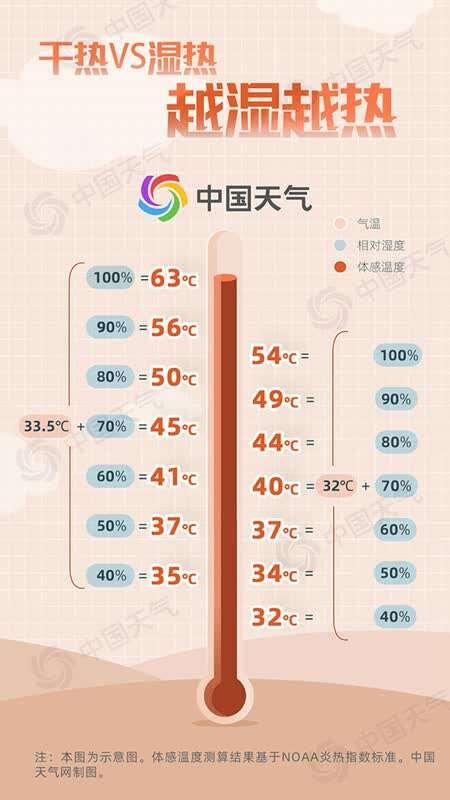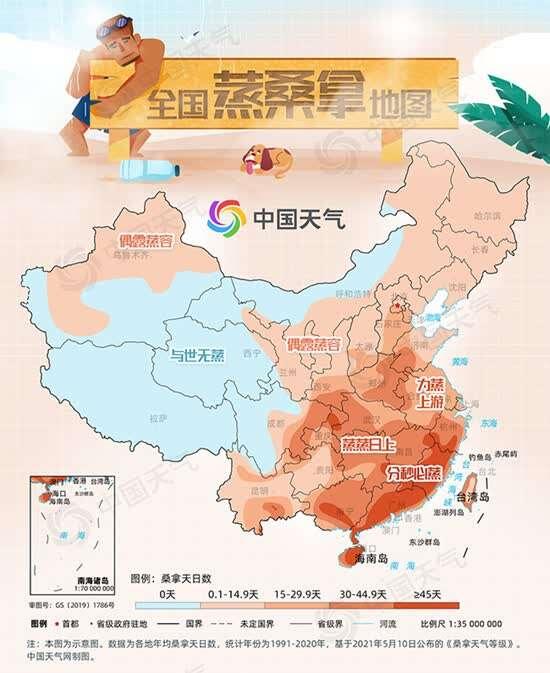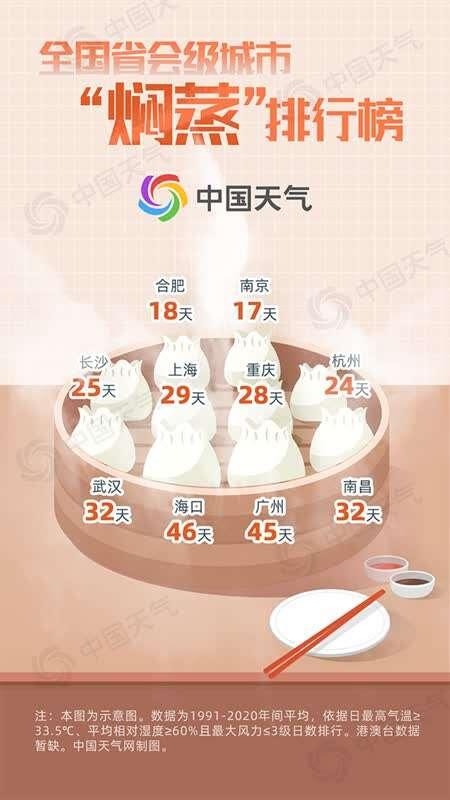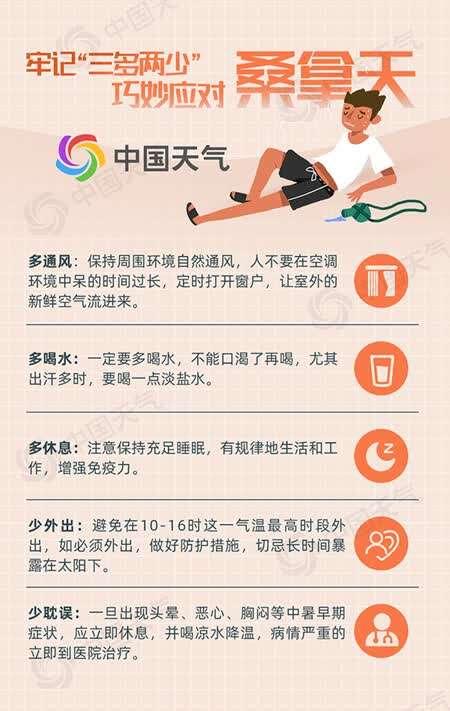China Weather Network News In recent two days, the largest and longest-lasting high-temperature weather in China has been "online" this year. The north and the south have started the high-temperature mode together, and the north is roasting and the south is steaming. Both netizens in the north and the south have shouted heat, and even sent out a soul torture about who is more unbearable. So who is hotter, dry, hot and humid? China Weather Netcom counted out the national sauna map and the steaming list of provincial-level cities with big data to see who has the highest thermal value.
Hot, dry and sultry, big PK sauna day wins by rolling
China Weather launched a poll on "Which is more uncomfortable, dry or stuffy" in Weibo. The results showed that 32,000 netizens chose "sultry sauna", accounting for 80%, while only about 20% chose "sunny barbecue". The "sultry sauna" can be described as a rolling victory.

Why is sauna day more collapsed?
It is also hot, why do people think that "sultry" is more devastating than "dry heat"? What is the weather like in sauna days?
Zhang Feng, deputy chief forecaster of the National Meteorological Center, said that according to the People’s Republic of China (PRC) meteorological industry standard "Sauna Weather Grade" released on May 10th this year, sauna days refer to the sultry weather with high temperature, high humidity and low wind speed, which gives people a feeling like a sauna.
Zhang Feng explained that the reason why sauna days are so uncomfortable is mainly because the heat in the human body cannot be spread out in time. In hot weather, the human body cools down by sweating, because sweat evaporates and absorbs heat, taking away the body’s heat. When the humidity of the surrounding environment is high, the evaporation speed of sweat will be greatly reduced, while the small wind speed will lead to the low flow speed of air, which will keep the high humidity environment around the skin and is even more unfavorable for evaporation.
Based on the same reason above, people’s feeling of temperature will be influenced by relative humidity, wind and other factors. When the temperature reaches a certain height, the higher the humidity, the higher the somatosensory temperature under the same temperature conditions.
NOAA heat index also shows that when the temperature is higher than a certain value, at the same temperature, the greater the relative humidity, the more obvious the increase of somatosensory temperature. When the temperature is 32℃ and the relative humidity reaches 60%, the somatosensory temperature can reach 37℃, and it will increase with the increase of humidity, and even reach 49℃ when the relative humidity reaches 90%.

Theoretically speaking, the somatosensory temperature caused by 37℃ combined with 28% relative humidity ≈ the somatosensory temperature caused by 32℃ combined with 60% relative humidity, so at the same temperature, the somatosensory temperature in hot and humid weather will be higher. However, the somatosensory temperature will also be affected by factors such as wind, and everyone’s perception is also different, so it still varies from person to person.
The map of sauna days in China is released, and "every minute must be steamed" in Guangdong and Hainan.
China Weather Network counted the big data from 1991 to 2020, and found that Hainan, Guangdong, Fujian and other places in China are the most frequent areas for sauna days, with an average annual number of sauna days exceeding 45 days, which is the place where every minute must be steamed. There are also many sultry days in Guangxi, Zhejiang, Jiangxi, Hunan, Hubei, eastern Henan and other places, with an average of more than 30 days per year, which can be described as "thriving"; In northern Hubei, Jiangsu, Anhui, southern Yunnan, Hebei, southern Beijing, southwestern Shaanxi and other places, the number of sauna days is 15-29 days, which can be described as "steaming upstream".

Sauna days in Heilongjiang, Jilin, Liaoning, northern Beijing, Shanxi, Gansu, Ningxia, northern Xinjiang and Guizhou belong to the level of "occasional dew steaming capacity", with an average annual number of days less than 15 days, and some areas are less than 5 days; The number of sauna days in Tibet, Qinghai, western Sichuan, northwestern Gansu, northern Inner Mongolia and southern Xinjiang in China is 0, which is a real "steaming-free" place.
High temperature ≠ sauna days Haikou Guangzhou leads the steaming list of provincial capital cities in China.
Sauna day is not equal to high temperature. When the temperature reaches 35℃, the high temperature can be judged. In contrast, sauna day has a slightly lower limit on temperature, but it needs to comprehensively consider three factors: temperature, relative humidity and wind speed. There are not necessarily many sauna days in areas with frequent high temperatures in China. For example, Guangdong and other places belong to "high temperatures don’t often exist, but sauna days often come". Take Guangzhou as an example, the average annual high temperature days are only 20 days, but the sauna days are as high as 45 days, which is twice as many as the high temperature days.
Statistics show that the provincial-level cities with the largest annual average sauna days are mainly concentrated in South China and the Yangtze River basin. Haikou and Guangzhou have an average annual sauna days of more than 45 days, and Wuhan, Nanchang, Shanghai, Chongqing, Changsha and Hangzhou generally have an average annual sauna days of more than 20 days.

In addition, "sauna days" is not a specific "product" in the south, and there are not many sauna days in North China, Huanghuai and other places. The average annual sauna days in Zhengzhou, Shijiazhuang, Tianjin and Beijing are all over 15 days.
Keep in mind "three more and two less" and deal with sauna days skillfully
In sauna days, people are more prone to heatstroke because of high temperature and high humidity. Moreover, in sultry environment, the human body consumes a lot, and sleep is easy to be bad. In addition, turning on the air conditioner and blowing the fan can easily lead to colds and colds. Everyone should keep in mind the five points of "three more and two less" and deal with sauna days skillfully.

Ventilation: Keep the surrounding environment naturally ventilated. People should not stay in the air-conditioned environment for too long. Open the windows regularly to let in fresh outdoor air.
Drink more water: be sure to drink more water, and don’t drink it when you are thirsty, especially if you sweat a lot, drink a little light salt water.
Take more rest: pay attention to keep enough sleep, live and work regularly, and enhance immunity.
Go out less: avoid going out at the highest temperature of 10-16 o’clock. If you have to go out, take protective measures and avoid being exposed to the sun for a long time.
Less delay: In case of dizziness, nausea, chest tightness and other early symptoms of heatstroke, you should rest immediately and drink cold water to cool down. If the condition is serious, you should go to the hospital immediately.
Attached:
According to the People’s Republic of China (PRC) meteorological industry standard "Sauna Weather Grade" issued on May 10th this year, in Beijing, Tianjin, Hebei, Shanxi, Inner Mongolia, Liaoning, Jilin, Heilongjiang, Shandong, Henan, Shaanxi, Gansu, Qinghai, Ningxia, Xinjiang, Sichuan, Guizhou, Yunnan and Tibet, it is determined that the daily maximum temperature is ≥32℃ and the daily average relative humidity is ≥ In Shanghai, Jiangsu, Zhejiang, Anhui, Fujian, Jiangxi, Hubei, Hunan, Guangdong, Guangxi, Hainan, Chongqing, Hong Kong, Macau, and Taiwan Province, the highest temperature on that day is ≥33.5℃, the daily average relative humidity is ≥60%, and the daily maximum wind force is ≤3, which is considered as a "sauna day".
(Planning/Zhang Hui Design/Zhang Li Data Support/Jiang Senwei Zhang Juan Shiyan Shao Peng Expert Support/Zhang Feng)
Source: China Weather Network
Reporting/feedback